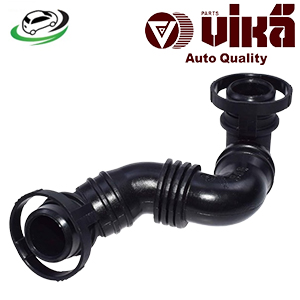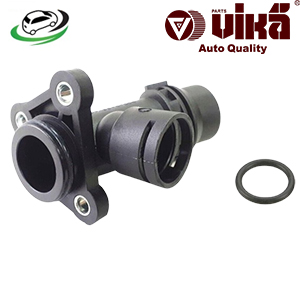-18%
Get Coolant Flange Audi A3 8P1 2003-2012 2.0L/Audi A3 8PA 2004-2013 2.0L / VW Touran 1T1/1T2 2003-2007 2.0L/VW Jetta 1K2 2005-2010 2.0L/Golf MKV/1K1 2003-2010 2.0L 06F121133A
The coolant flange is a key component in a vehicle’s engine cooling system. It serves as a junction where coolant flows from one part of the engine to another, helping to regulate engine temperature and ensure efficient operation. Understanding the function, types, symptoms of failure, and maintenance of the coolant flange is essential for maintaining optimal engine performance and preventing potential cooling system issues.
Functionality of the Coolant Flange
The coolant flange performs several important functions in the engine cooling system:
- Coolant Distribution: The primary role of the coolant flange is to facilitate the distribution of coolant throughout the engine. It acts as a connection point for coolant hoses and channels coolant to different parts of the engine, such as the thermostat housing, water pump, or heater core.
- Temperature Regulation: By directing coolant flow, the flange helps regulate engine temperature, ensuring that the engine operates within its optimal temperature range. This prevents overheating and maintains efficient engine performance.
- Prevent Leaks: The flange is designed to create a tight seal between different parts of the cooling system, helping to prevent coolant leaks and maintain the pressure within the system.
Components of the Coolant Flange
A typical coolant flange assembly includes the following components:
- Flange Body: The main part of the flange, usually made from aluminum or plastic, which houses the coolant passages and provides a mounting surface for hoses or other components.
- Gasket or Seal: A gasket or seal is used to ensure a tight, leak-proof connection between the flange and the engine block or other components. It helps maintain proper pressure and prevents coolant leaks.
- Bolt or Clamp: Bolts or clamps are used to secure the flange in place and ensure a proper seal. They help hold the flange against the engine and keep it securely fastened.
- Coolant Passages: Internal passages within the flange allow coolant to flow from one component to another. These passages are designed to direct coolant efficiently and minimize turbulence.
Types of Coolant Flanges
Coolant flanges come in various types, depending on their application and design:
- Thermostat Flange: This type of flange is connected to the thermostat housing and helps direct coolant flow to and from the thermostat. It plays a crucial role in regulating engine temperature by controlling the flow of coolant based on temperature readings.
- Water Pump Flange: The water pump flange is attached to the water pump and helps distribute coolant throughout the engine. It ensures that coolant is effectively circulated, contributing to efficient engine cooling.
- Heater Core Flange: This flange connects to the heater core and allows coolant to flow through the core, providing heat to the vehicle’s interior. It plays a role in both engine cooling and cabin heating.
- Universal Flange: Some vehicles use universal flanges that can be adapted to various cooling system components. These flanges offer flexibility in applications and are often used in aftermarket or custom installations.
Symptoms of a Failing Coolant Flange
Recognizing the signs of a failing coolant flange is crucial for preventing cooling system issues and engine damage:
- Coolant Leaks: A common symptom of a failing coolant flange is coolant leakage around the flange area. This can lead to low coolant levels and potential overheating.
- Overheating Engine: If the flange is not directing coolant properly, it can cause the engine to overheat. This may be accompanied by the temperature gauge reading higher than normal or the engine warning light illuminating.
- Low Coolant Levels: Persistent drops in coolant levels can indicate a problem with the flange or its seal. Regularly check coolant levels and look for signs of leakage around the flange.
- Coolant Odor: A sweet or antifreeze odor inside the vehicle or around the engine bay can indicate a coolant leak from the flange or other cooling system components.
- Engine Performance Issues: Overheating caused by a failing flange can lead to reduced engine performance, including loss of power, rough idling, or unusual engine noises.
Causes of Coolant Flange Failure
Several factors can contribute to coolant flange failure:
- Wear and Tear: Over time, the flange and its components can wear out due to exposure to high temperatures, pressure, and coolant chemicals. This can lead to leaks or poor performance.
- Corrosion: Corrosion can occur due to the interaction between coolant and the flange material, especially if the coolant is not regularly changed or is contaminated.
- Improper Installation: Incorrect installation or insufficient tightening of bolts or clamps can lead to leaks or poor sealing of the flange.
- Physical Damage: Impacts or accidents can damage the flange or its seal, affecting its ability to maintain proper coolant flow and pressure.
Maintenance and Replacement
Proper maintenance of the coolant flange involves regular inspections and timely replacements to ensure optimal performance:
- Regular Inspections: Periodically inspect the coolant flange and its components for signs of wear, damage, or leakage. Check for coolant stains or puddles around the flange area.
- Follow Manufacturer’s Recommendations: Adhere to the manufacturer’s recommended maintenance intervals for coolant system components, including the flange. This information can be found in the vehicle’s owner’s manual.
- Replace as Needed: If any symptoms of a failing flange are observed, or if the flange is damaged or leaking, replace it promptly to prevent potential overheating and engine damage.
Replacement Process
Replacing a coolant flange typically involves the following steps:
- Prepare the Vehicle: Ensure the engine is off and has cooled down. Open the hood and locate the coolant flange. If necessary, lift the vehicle using a jack and jack stands to access the flange.
- Drain the Coolant: Before removing the flange, drain the coolant from the system to prevent spills. This can be done by opening the radiator drain valve or removing the lower radiator hose.
- Remove the Old Flange: Disconnect any hoses or components attached to the flange. Remove the bolts or clamps securing the flange in place and carefully remove it from the engine.
- Clean the Surface: Clean the mating surfaces on the engine block and flange to ensure a proper seal with the new gasket. Remove any old gasket material or sealant.
- Install the New Flange: Position the new flange in place and secure it with the appropriate bolts or clamps. Ensure the gasket or seal is properly aligned and seated.
- Reattach Hoses: Reconnect any hoses or components that were disconnected during the removal process.
- Refill the Coolant: Refill the cooling system with the recommended coolant and check for proper levels. Bleed any air from the system if necessary.
- Test the Vehicle: Start the engine and check for leaks or unusual noises around the flange area. Monitor the temperature gauge and ensure the engine is operating within the normal temperature range.
Importance of Quality Coolant Flanges
Using high-quality coolant flanges is essential for several reasons:
- Performance: Quality flanges ensure effective coolant distribution and proper sealing, maintaining optimal engine temperature and performance.
- Durability: High-quality materials and construction enhance the flange’s longevity, reducing the need for frequent replacements and preventing premature failure.
- Reliability: Reliable flanges provide consistent performance of the cooling system, preventing potential overheating and engine damage.
- Cost-Effectiveness: Investing in a quality coolant flange can prevent costly repairs and maintain overall vehicle efficiency.
Follow us on Facebook for more parts.





